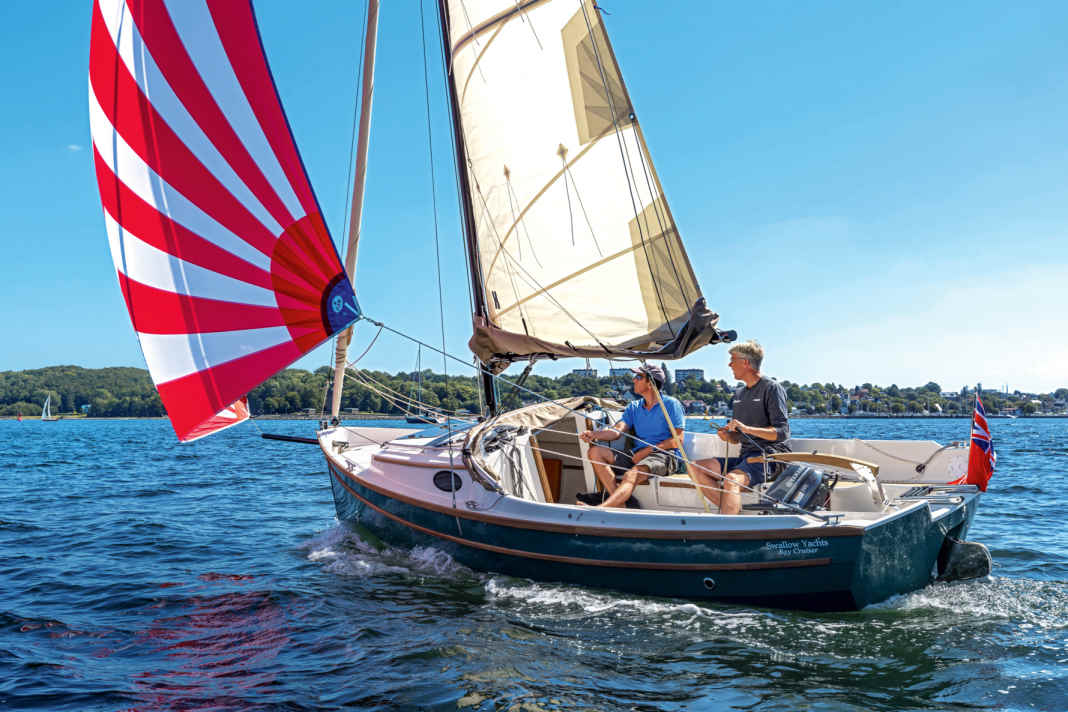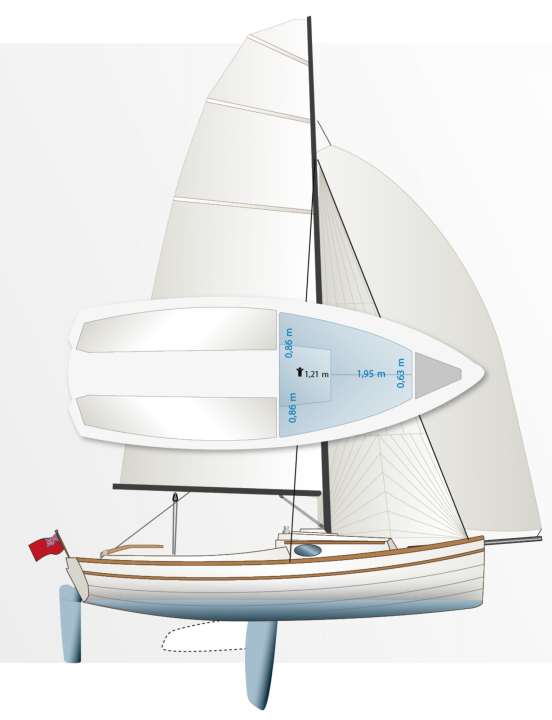





- Assembly of the Baycruiser 21 is quick and easy
- Shipyard relies on engines in the shaft
- Water ballast transforms dinghy into keelboat
- The measured values for testing the Baycruiser 21
- The Baycruiser 21 in detail
- Equipment and prices
- Shipyard and distribution
- YACHT review of the Baycruiser 21
Everyone is familiar with the phenomenon: you stroll along the jetty, your gaze wanders over the yachts moored alongside and suddenly a boat stands out from the white GRP mass-produced monotony: curved lines, bold deck lines, varnished wood on the hull. Your gaze lingers, you stop, pause and your subconscious sends out the message: nice boat! Often enough, these are classic yachts. Then comes the second impulse: but all that work!
But that doesn't have to be the case. Because there are the so-called retro classics. Classic looks, but contemporary sailing technology. In the case of the Baycruiser, this means a GRP hull in a dark green clinker design, lines in the style of traditional British fishing boats, carbon fibre rig, fat-head main, modern rudder blade and water ballast.
Also interesting:
For some years now, the Welsh shipyard Swallow Yachts, which exclusively builds small, trailerable yachts up to 26 feet, has been proving that such boats are not only available to exceptionally well-heeled sailors. The British have thus reinterpreted a niche that was long occupied by the Cornish Crabbers shipyard, which also built in GRP, but in a much more classic and heavier style, including a wooden mast with gaff rig and steel centreboard. However, Cornish Crabber has run into troubled waters, in March the shipyard had to file for insolvency, a buyer was found, but the website is currently still offline.
Assembly of the Baycruiser 21 is quick and easy
But back to Swallow Yachts: their retro classics are also something of an old acquaintance. The YACHT has already Baycruiser 23 (YACHT 21/16) and 26 (6/2017) was tested. The 21-footer now rounds off the range at the bottom.
We meet shipyard boss Matt Newland for a test on the Kiel Fjord in Mönkeberg. We are somewhat surprised to see that the boat is still high and dry on the single-axle trailer when we arrive. "I wanted to show you how quickly the boat is ready for use, because we optimise it for this, many of our customers are regularly out and about with the trailer or have the boats on land." This is not surprising, as moorings are rare on the British coast and cost many times more than in Germany. In this country, the concept is more popular due to the lack of mooring space and the trailer boat also opens up countless fantastic areas throughout Europe.
And so the set-up becomes a challenge: we simply time how long it takes Newland alone to get the trailer ready for the slip ramp. 3, 2, 1 - go! Of course, the builder is experienced in every move. And so the first clever details immediately catch the eye: The rig and boom lie on a customised carrier with fixed elasticated straps. Released in a flash, it connects the Dynema shrouds and forestay to the jib and bow fittings.
The rig is a carbon fibre mast without spreaders and backstay. Bolts through the foot of the mast, the owner adjusts the feather-light profile with one hand. Then comes the highlight: boom, mainsail and lazy-jack are a packed unit. Instead of a lazy-jack fitting, a piece of carbon fibre is installed that fits snugly against the mast. This allows you to simply detach the boom and sail from the mast when rigging. No need to attach and detach. The cassette slides into place, tighten two screws and you're done. The engine simply remains in the shaft when trailering. The clock stops at 9 minutes 36. That was really quick.
Shipyard relies on engines in the shaft
The Baycruiser has 400 kilos of water ballast instead of a ballast centreboard. This means that the boat weighs only 600 kilos, 950 with trailer, and can therefore be easily towed on a braked trailer by any mid-range car. The lightweight floats on the slip ramp before the wheel hub is even in the salt water. The bearings thank you.
But now off to the fjord. The wind there is very restrained and turning at two to three Beaufort, so we set off with the engine. With its 6 hp outboard engine, the Baycruiser is sufficiently motorised, and electric versions are also available. The shipyard relies on engines in the shaft, which extends far into the cockpit and is halfway closed by plastic louvres when folded up, similar to a centreboard box. This is not the best solution for performance, but it is easier to operate in rough seas than when attached to the stern and the prop does not dive out so quickly in the waves. There is an extra compartment in the cockpit for the plastic fuel tank. It is very spacious and sits four people very comfortably for the duration of a day trip. The raised cockpit coaming offers good support for the back and protection from overflowing water. The fully battened, cream-coloured and wide flared Fat Head Dacron main from Hyde is quickly set and the small headsail unfurled. Unfortunately, there is no traveller for the main.
Due to the lack of wind, we are initially sailing without the 400 litres of water ballast. The 1.5 metre deep GRP centreboard only weighs a few kilos at the top. However, the ballast-free version is only recommended for experienced dinghy sailors, as the boat quickly heels away in the moderate gusts. However, anyone who reacts to the sheet and has dinghy experience will enjoy it. According to the boatyard, it can be sailed up to just under four Beaufort.
When we set the optional gennaker, which is attached to a carbon fibre spinnaker attached to the deck, the boat really gets going and even flashes a 7 on the log. The small Welshman is easy to steer with the modern rudder blade, but you should definitely order the optional tiller jib. The Baycruiser is fun to sail. It quickly reaches 4 knots on the wind, and when the wind picks up, this is immediately converted into speed. The turning angle on smooth water is 90 degrees.
In the rare gusts of around 10 knots, it turns out that the mainsheet is fastened too low to the ground. The angle of pull is unfavourable and even with so little wind you can feel that it could do with more deflection for windy days. Shipyard boss Newland promises an upgrade.
Water ballast transforms dinghy into keelboat
A clever feature on the tiller proves to be quite practical: in addition to the catch for the rudder blade, it also has clamping lines that almost fix the rudder in the respective position. Dinghy sailors are familiar with such constructions with rubber stoppers on both sides. This is enough to keep the boat travelling straight ahead for a while if it is well trimmed.
Now we want to know how the boat sails with a full ballast tank. It can also be flooded when the boat is in the water, for example downwind. To do this, you screw on a bucket-sized lid in the cockpit floor with a drain plug underneath. This is then simply screwed on and the water gushes into the tank, which is optimised for trimming under the cockpit floor. It takes about 20 minutes for the water to reach cockpit floor level. You have to wait that long, the tank should only be used completely empty or completely full. Screw in the drain plug, put the cap on and continue.
You can immediately feel that the dinghy has become a keelboat. Gusts are parried with less leeway, the movements are smoother. The speed is also reduced by around 0.3-0.5 knots, but this is difficult to say exactly in the patchy wind. In any case, the Baycruiser 21 is a lot of fun even with ballast.
We sail back into the harbour, time for a look below deck. It's spartan there: a large sunbathing area offers comfortable space for two people, a porta potti fits under the companionway - and that's about it. Storage space is limited, as the ballast tank is located under the cockpit floor. A cartridge gas cooker can be stowed in an extra compartment under the port bench seat, but there is no sink, so only the bailer will do. The forecastle boxes are nice and large, with plenty of space for lines, fenders and luggage. The anchor and chain fit into the compartment in the bow. The optional sprayhood offers very good protection and can be combined with a cockpit tent. The Baycruiser is then also equipped for longer trips.
With a base price of just under 40,000 euros, the boat is in the mid-range between the more affordable Polish boats such as the Viko 21 (22,990 euros), solid tourers such as the Sailart 20 (42,000 euros) or chic daysailers such as the Pointer 22 (51,250 euros). But visually, the Baycruiser has a unique character thanks to its historical references: an eye-catcher if you like the style, sails well and is perfect for trailering. A real jewel in the crown.
The measured values for testing the Baycruiser 21



The Baycruiser 21 in detail

Technical data of the Baycruiser 21
- Designer: M. Newland
- CE design category: C
- Torso length: 6,02 m
- Total length: 6,02 m
- Waterline length: 5,67 m
- Width: 2,18 m
- Draught/alternative: 1,5/0,25 m
- Theor. torso speed: 5.7kn
- Weight: 0,6 t
- Ballast/proportion: 0,4 t/40 %
- Mainsail: 13,5 m2
- Furling jib: 5,46 m2
- Gennaker: 20 m2
- Engine (AB 1 cyl., 4T/electric): 6 HP
- Fuel tank (external): 12 l
Hull and deck construction
GRP laminate using the hand lay-up method with foam core (Divinicell). The hull is built in Poland and finished in Wales
Ballast concept
The righting moment of the filled ballast system reaches zero at 108 degrees, without at 80 (AVS).
The rig
No backstay and no spreaders are unusual, but an extra three-layer reinforced carbon fibre profile should ensure sufficient stability in windy conditions.
Trailering
A braked single-axle trailer costs around 4000 euros. As England is no longer a member of the EU, it makes more sense to buy in Europe than in Wales/England.
Equipment and prices
- Base price ex shipyard: 39.774 €
- Price ready to sail: 46.656 €
- Comfort price: 49.136 €
- Guarantee/against osmosis: 2 years
As of 08/2024, how the prices shown are defined can be found here!
Shipyard and distribution
Shipyard
Swallow Yachts, Gwbert Road, Cardigan, Ceredigion, SA43 1PN, UK, www.swallowyachts.com
Distribution
Direct sales via the shipyard
YACHT review of the Baycruiser 21
Very successful retro classic, optimised as a trailer boat and with good sailing performance.
Design and concept
- + Trailer optimised
- + Modern attachments/rig
- + Classic style borrowings
Sailing performance and trim
- + Agile sailing boat, can be used without ballast in light winds
- - Mainsheet insufficient reduction
Living and finishing quality
- + Good finish
- - Less storage space due to water ballast tank
- - No sink, cooker only in cockpit, toilet under companionway
Equipment and technology
- + carbon fibre rig and boom
- + Good fittings
The test first appeared in YACHT issue 20/2024

